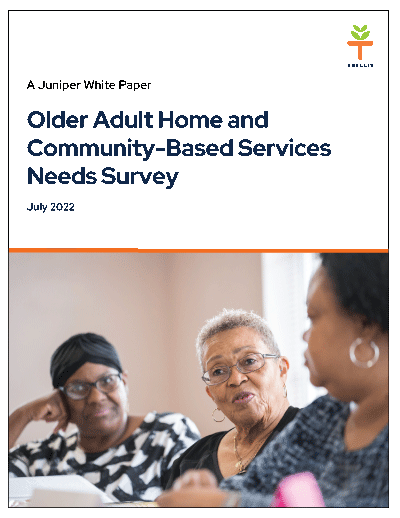As a way to better understand their knowledge of home-based support, Trellis surveyed older adults about services and resources that could help them age in place.

Trellis surveyed older adults to understand their awareness of and willingness to use services and supports that would help them remain safely in their homes and communities. The survey also covered their use of technology and which resources of health information they trusted, to better understand and serve older adults.
Trellis embarked on this important research because it aligns with its mission and every-day work: to help older adults optimize well-being as they age. Survey respondents were past participants of Juniper evidence-based health promotion classes.
It’s not news that most older Americans want to age in place. A 2021 "Home and Community Preferences Survey” conducted by AARP finds that “Data shows that 77 percent of adults 50 and older want to remain in their homes for the long term — a number that has been consistent for more than a decade.” [https://www.aarp.org/home-family/your-home/info-2021/home-and-community-preferences-survey.html#:~:text=%EF%BB%BF%22%20Data%20%EF%BB%BFshows%20that,for%20more%20than%20a%20decade.]
Yet to remain in their own homes, many older adults will need both clinical and non-clinical help and support. However, very few older adults can afford to pay out of pocket for much-needed home and community-based services. Those who can’t afford these fees must go without, depend on a family caregiver or navigate a fragmented system of services.
This is supported by a 2020 research report by AARP (4), which finds that almost 42 million Americans are caring for an adult 50 years of age or older – a 22% increase from 2015. And notably, about one in 4 of these caregivers said, “it is difficult to get affordable services in their recipient’s area (27 percent).” [4 https://www.aarp.org/ppi/info-2020/caregiving-in-the-united-states.html}
Goal of the Survey
The goal of the survey was to learn:
- What services and supports older adults feel they need to live independently in their own homes.
- Awareness of, and willingness to use, the available home and community-based services if they needed them.
- How they would obtain those services if they needed them (without reference to payment or reimbursement)
- The likelihood of them using those services — if they were available through their health plan — and how that availability would influence their choice of health plans.
The survey results indicate that older adults value home and community-based services, such as transportation, chores, indoor and outdoor home maintenance, homemaking services and more. Most respondents indicated they would be motivated to choose health plan coverage that pays for these types of services.
Dawn Simonson, president and CEO of Trellis, said the results of the survey shed light on older adults’ needs now and into the future. She noted: “We believe information from the survey could help healthcare and community-based organizations and other stakeholders better tailor future benefits and services they offer to their members, patients and communities they serve.”
Survey Findings
Responses to the survey questions showed that:
- The most desired services were indoor repair and maintenance, outdoor home repair and maintenance and transportation. Other sought-after services included homemaker-chore help and home modifications to make their homes safer.
- Help and support for family caregivers rated high on the list.
- Most respondents said they would hire an outside service provider to deliver needed services rather than depend on family members. The exceptions were for medication management, transportation and homemaker chores.
- Cost was the lead consideration in hiring an outside service provider, followed by the reliability and qualifications of the provider and safety and security.
Seventy-five percent of respondents said that having non-clinical services and supports available to them would affect their health plan enrollment decisions.
Technology Use and Trusted Sources of Health Information
Survey responses indicate that concerns about inaccessibility to technology for communication purposes among older adults may be overstated, as respondents said they regularly use many devices and are comfortable using smartphones, land lines, tablets, notebooks and laptops.
When it comes to health-related information, respondents trust only three sources to any substantial degree: overwhelmingly, “physician or other healthcare provider” (91%), followed by “family or friends” (43%) and health plan mailed information” (39%). This data reinforces the important role that healthcare providers and healthcare plans have in fostering whole-person care for older adults.
Read the White Paper: [link to where the survey document is on the website]